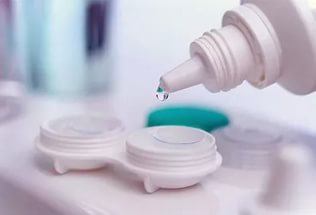How to put on and remove contact lenses
Contact lenses have long established themselves as a convenient means of correcting vision impairment. Most people who decide to purchase soft optics for the first time experience difficulties associated with the process of fixing them on their eyes. This is due to the person’s fear of encountering painful sensations in the sensory organ, damage to the lenses due to lack of experience when putting them on.
Fears will disappear if you familiarize yourself with information that allows you to teach proper use and avoid possible problems. The information material will also be useful to owners of lenses who had to take a long break from wearing them.
The content of the article
Rules of use for people doing this for the first time
Important! Contact lenses for first use should be purchased only after consultation with an ophthalmologist, as there are several contraindications:
- eye allergies;
- ptosis;
- blepharitis;
- conjunctivitis;
- dacryocystitis;
- xerophthalmia;
- keratitis;
- obstruction of the lacrimal canal;
- violation of the composition of tear fluid;
- infectious diseases.
Wearing contact lenses
 The first fitting should take place under the supervision of a doctor in compliance with the following rules:
The first fitting should take place under the supervision of a doctor in compliance with the following rules:
- Thoroughly clean your hands with neutral soap, dry with a towel that does not leave fibers or under a stream of warm air.
- Remove the lens from the container with silicone tweezers and place it on the pad of the index finger. Inspect it in bright light for the absence of microcracks, dirt, and uneven edges.
- A soft optics product with defects is replaced. The lens with small fibers on the surface is cleaned under a stream of a special solution. The lens, turned inside out, is given the desired position, otherwise it will soon fall out of the eye.
- It is advisable to carry out all actions while sitting at a table, with a mirror placed close in front of you. The table cover must be clean so that it does not get dirty if it falls.
- Before applying contact correction products to the visual organ, it is necessary to open the eyelids. This can be achieved by pulling down the lower fold of skin around the eye with your finger. While looking upward, the lens is placed on the lower area of the eyeball under the pupil. The index finger is removed, the eye is lowered to the lower position, and the fold is released. For better fixation, it is recommended to hold your eyes for a while with your eyelids closed, then blink them slightly.
- Beginner users will find it convenient to spread their eyelids apart with two fingers before installation. In this situation, the upper skin fold is pulled upward from the eye with the middle finger of the left hand, and the lower fold is pulled down with the middle finger of the right hand. The application is carried out with the index finger of the same hand. It is recommended to hold the eyelids for a while in such positions, look first down, then to the left and right sides, and only then release the eyelids.
If the process of installing soft optics is carried out correctly, there should not be a feeling of the presence of a foreign object in the eye organs.
Removing contact lenses
 Removing them will not be difficult if you try to follow the following recommendations:
Removing them will not be difficult if you try to follow the following recommendations:
- You need to look up. It is better to carefully move the lower eyelid down with your middle finger, and use the pad of your index finger to move the lens from its previous position.
- Use two fingers to lightly squeeze the lens. It is unacceptable to forcefully clamp it, as this may lead to gluing.
- Remove the product, place it in the compartment of the case, fill it with a special solution.
How to use it correctly without harming your health
Having mastered the basic rules of donning, you must further adhere to recommendations that help maintain the health of the eyeballs when regularly wearing soft optics, such as:
- Be careful when putting on and taking off, avoid wearing for long periods of time without breaks. Otherwise, due to constant irritation of the cornea, areas of erosion may develop on it. Over time, persistent clouding of the cornea and decreased visual acuity may form.
- Consult an ophthalmologist when changing type and type of lenses. Different types with the same optical power value differ in the radius of curvature. The lens will not fit correctly on the eyeball if the radius is chosen incorrectly. If the landing is too flat or steep, superficial infiltrates occur and pinpoint superficial keratitis develops.
- During illness, do not take medications that can cause staining of soft optics. You should carefully read the instructions for use of medications.
- In cases where monocular vision correction is prescribed, it is necessary to avoid conditions that require visual tension.
- During pregnancy, wearing is allowed only during the day. Changes occur in the body of a pregnant woman, and there are cases of temporary myopia.
- After eye surgery, consultation with ophthalmologist.
- Contact vision correction can be indicated for children from 5 years of age. The difficulty lies in teaching a child to wear lenses.
- It is not advisable to take water procedures while wearing lenses. There is a risk of loss of optics and the possibility of organic substances getting into the eyes along with water, which settle on them and serve as a breeding ground for various types of pathogenic bacteria.
- Optical plates should be put on before applying makeup and removed before removing it. It is recommended to use cosmetics that are made without aromatic or oily components, that are waterproof, and do not fall off.
- Wearing in unfavorable environmental conditions has its own characteristics. It is not recommended to use optical plates for long periods of wear in places where there is increased dustiness in the air and lack of oxygen. The preferred option is daily lenses.
The health of the eyes, which experience continuous exposure to contact lenses, largely depends on the care they receive.
Care
 Care is quite simple, just follow simple rules:
Care is quite simple, just follow simple rules:
- Store lenses in a special case.
- Use a solution for disinfection and storage of soft optics, purchased only at a pharmacy or specialized center.
- Strictly follow the instructions for the multifunctional solution.
- Change the disinfectant liquid in the container daily.
- Rinse the case daily and dry it.
- Replace the case once a month.
How to choose
 Only a doctor can help you choose the right model. Before visiting an ophthalmologist, it is still useful to acquire information regarding the question: “how to choose a suitable soft optics product.” First, the doctor evaluates:
Only a doctor can help you choose the right model. Before visiting an ophthalmologist, it is still useful to acquire information regarding the question: “how to choose a suitable soft optics product.” First, the doctor evaluates:
- fundus condition;
- degree of visual acuity;
- corneal curvature;
- general condition of the eye.
Then, contact specialist offers a suitable option, in agreement with the patient:
- wearing mode;
- replacement time;
- design type.





